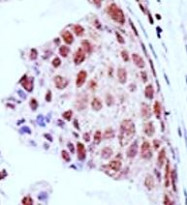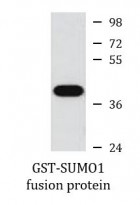ARG54890
anti-SUMO1 antibody
anti-SUMO1 antibody for Flow cytometry,IHC-Formalin-fixed paraffin-embedded sections,Western blot and Human
Cancer antibody; Cell Biology and Cellular Response antibody; Cell Death antibody; Metabolism antibody
Overview
| Product Description | Rabbit Polyclonal antibody recognizes SUMO1 |
|---|---|
| Tested Reactivity | Hu |
| Predict Reactivity | Ms, Rat, Bov, Pig |
| Tested Application | FACS, IHC-P, WB |
| Host | Rabbit |
| Clonality | Polyclonal |
| Isotype | IgG |
| Target Name | SUMO1 |
| Antigen Species | Human |
| Immunogen | KLH-conjugated synthetic peptide corresponding to aa. 55-86 (C-terminus) of Human SUMO1. |
| Conjugation | Un-conjugated |
| Alternate Names | OFC10; UBL1; SMT3C; Ubiquitin-like protein UBL1; Small ubiquitin-related modifier 1; PIC1; SMT3H3; SMT3; DAP1; Ubiquitin-like protein SMT3C; SENP2; Smt3C; GAP-modifying protein 1; Ubiquitin-homology domain protein PIC1; SUMO-1; SMT3 homolog 3; GMP1; Sentrin |
Application Instructions
| Application Suggestion |
|
||||||||
|---|---|---|---|---|---|---|---|---|---|
| Application Note | * The dilutions indicate recommended starting dilutions and the optimal dilutions or concentrations should be determined by the scientist. |
Properties
| Form | Liquid |
|---|---|
| Purification | Purification with Protein G. |
| Buffer | PBS and 0.09% (W/V) Sodium azide |
| Preservative | 0.09% (W/V) Sodium azide |
| Storage Instruction | For continuous use, store undiluted antibody at 2-8°C for up to a week. For long-term storage, aliquot and store at -20°C or below. Storage in frost free freezers is not recommended. Avoid repeated freeze/thaw cycles. Suggest spin the vial prior to opening. The antibody solution should be gently mixed before use. |
| Note | For laboratory research only, not for drug, diagnostic or other use. |
Bioinformation
| Database Links |
Swiss-port # P63165 Human Small ubiquitin-related modifier 1 |
|---|---|
| Gene Symbol | SUMO1 |
| Gene Full Name | small ubiquitin-like modifier 1 |
| Background | This gene encodes a protein that is a member of the SUMO (small ubiquitin-like modifier) protein family. It functions in a manner similar to ubiquitin in that it is bound to target proteins as part of a post-translational modification system. However, unlike ubiquitin which targets proteins for degradation, this protein is involved in a variety of cellular processes, such as nuclear transport, transcriptional regulation, apoptosis, and protein stability. It is not active until the last four amino acids of the carboxy-terminus have been cleaved off. Several pseudogenes have been reported for this gene. Alternate transcriptional splice variants encoding different isoforms have been characterized. [provided by RefSeq, Jul 2008] |
| Function | Ubiquitin-like protein that can be covalently attached to proteins as a monomer or a lysine-linked polymer. Covalent attachment via an isopeptide bond to its substrates requires prior activation by the E1 complex SAE1-SAE2 and linkage to the E2 enzyme UBE2I, and can be promoted by E3 ligases such as PIAS1-4, RANBP2 or CBX4. This post-translational modification on lysine residues of proteins plays a crucial role in a number of cellular processes such as nuclear transport, DNA replication and repair, mitosis and signal transduction. Involved for instance in targeting RANGAP1 to the nuclear pore complex protein RANBP2. Polymeric SUMO1 chains are also susceptible to polyubiquitination which functions as a signal for proteasomal degradation of modified proteins. May also regulate a network of genes involved in palate development. [UniProt] |
| Cellular Localization | Nucleus membrane. Nucleus speckle. Cytoplasm. Nucleus, PML body. Note=Recruited by BCL11A into the nuclear body. |
| Research Area | Cancer antibody; Cell Biology and Cellular Response antibody; Cell Death antibody; Metabolism antibody |
| Calculated MW | 12 kDa |
| PTM | Cleavage of precursor form by SENP1 or SENP2 is necessary for function. Polymeric SUMO1 chains undergo polyubiquitination by RNF4. |
Images (3) Click the Picture to Zoom In
-
ARG54890 anti-SUMO1 antibody IHC-P image
Immunohistochemistry: Formalin-fixed and paraffin-embedded Human breast carcinoma tissue stained with ARG54890 anti-SUMO1 antibody.
-
ARG54890 anti-SUMO1 antibody WB image
Western blot: GST-SUMO1 fusion protein stained with ARG54890 anti-SUMO1 antibody.
-
ARG54890 anti-SUMO1 antibody FACS image
Flow Cytometry: HeLa cells stained with ARG54890 anti-SUMO1 antibody (right histogram) or without primary antibody control (left histogram), followed by incubation with FITC labelled secondary antibody.








